2021 Tata Altroz BS VI STARTING AND DRIVING Instruction
The 2021 Tata Altroz BS VI is a great example of how modern tech and efficient driving can work together to make a great car. The Altroz shows how committed Tata is to protecting the environment by meeting Bharat Stage VI (BS VI) emission standards. In addition to reducing emissions, the Altroz’s starting and moving systems have been carefully thought out to give drivers a smooth ride. The Altroz’s ability to start and drive is a good example of how performance and environmental awareness can work well together. For example, the engine can be started with precision, the car can change to different driving modes, and it can use fuel-saving technologies like start-stop systems. As the road opens up in front of the 2021 Tata Altroz BS VI, it tells a gripping story of responsible driving. Every time you turn on the engine or change gears, it tells a story of technological skill and responsible mobility.
STARTING AND DRIVING
Pre Driving Checks
Make sure that
- Windshield, windows, mirrors, lights, and reflectors are clean and unobstructed.
- Tool kit, jack & handle, warning triangle, owner’s manual, first aid kit and vehicle documents are available and stored at their locations.
WARNING
Do not put any mat on the floor carpet near control pedals area.
- All doors, engine bonnet and tail gate are securely closed and latched.
- All occupants should always wear seat belts or suitable CRS as applicable while travelling.
- Objects, luggage or loads are secured correctly against slipping or tipping.
- Rear seat is securely latched.
- There is sufficient fuel for the trip.
Daily check
- Tyres for unusual wear, cracks or damage and embedded foreign material such as nails, stones, etc.
Traces of fluid and oil below vehicle.
NOTE
Water dripping below the car is normal. This is due to the usage of air conditioning system.
- All lamps, wipers, wiper blades and horn for proper operation.
- All switches, gauges and tell tales are working properly.
Adjust:
- Seats, head restraints and steering Wheel position.
- Adjust all the mirrors before you start the car.
Weekly check
- Engine oil level
- Coolant level
- Brake fluid level
- Windshield washer fluid level
- Battery electrolyte level
- Fuel level
NOTE
Tyre pressure should always be measured in cold conditions. Do a check of the tyre pressure and condition after every 15 days, including the spare tyre.
Driving Tips
Fuel consumption, engine, transmission, brake and tyre wear are mainly affected by the below factors:
- Operating conditions of your vehicle
- Your personal driving style.
Operating conditions
- Avoid frequent starts and stops as these actions increase the fuel consumption of the vehicle.
- Always ensure correct tyre pressure.
- Do not carry any unnecessary weight.
- Regularly service your vehicle and adhere to the recommended service maintenance schedule
Personal driving style
- Do not press the accelerator pedal when starting the engine.
- Do not warm up the engine when the vehicle is stationary.
- Always adapt your driving style to suit the prevailing road, weather conditions, and maintain a safe distance from the vehicle in front. Drive carefully.
- Avoid frequent, sudden acceleration and braking.
- Select appropriate gear according to varying speeds and load conditions.
NOTE
Do not rest your foot on the clutch pedal while driving.
- Switch ‘OFF’ the engine in stationary traffic or at signals.
- Keep an eye on the vehicle’s fuel consumption.
- Safety systems are merely aids designed to assist driving. You are responsible for the distance between the vehicles in front, for vehicle speed and for anticipating braking in good time.
WARNING
You could lose control of your vehicle if you try to adjust the driver’s seat, head restraint, mirror, steering wheel and fasten the seat belt while driving. There is a risk of an accident.
Do not rest your hand on the shift lever during driving; Pressure transmitted from your hand may result in premature wear of the transaxle internal gear shift mechanism. Press the clutch fully while shifting the gears. The reverse gear should be engaged only when the vehicle is stationary. Transmission may get damage by trying to shift into reverse gear while the vehicle is moving. Wait for 5 seconds after declutching to ensure smooth engagement of the reverse gear or shift into one of the forward gears for a moment while clutch is pressed fully. This will avoid grinding of reverse gear while shifting.
Recommended fuel economy speeds
|
Gear |
Diesel | Petrol |
| Speed(kmph) Speed(kmph) | ||
| 1 | 15 | 20 |
| 2 | 30 | 35 |
| 3 | 50 | 55 |
| 4 | 65 | 75 |
| 5 | 85 | 95 |
Good driving practices
- Slow down before you shift to a lower gear. This helps the engine to keep a lower rpm and result in less wear and tear of the engine components.
- Avoid frequent brake application which can cause overheating of brakes.
- Slow down the vehicle when you drive in cross winds to get better control over the vehicle.
- Avoid high speed when cornering or turning.
- Press the clutch fully while shifting gears.
- Make sure that vehicle is completely stationary before you attempt to shift in reverse gear.
- Drive slowly on wet roads.
- You can get extra braking from the engine by shifting to a lower gear. This can help you to maintain a safe speed and prevent your brakes from overheating specially while going down a hill.
Tips for obtaining better fuel efficiency
- Always maintain the specified tyre pressure during fuel top-ups and also before a long trip. Vehicle running with low tyre pressure will consume more fuel than the one running with specified tyre pressure.
- Keep the vehicle clean. Get rid of the unwanted stuff lying in the boot etc., to reduce weight.
- Regularly inspect your vehicle for any leakages, worn out wires, damaged by rat bites etc.
- Always follow periodic & regular service schedule of the vehicle.
- In places with high dust content. Clean the air filter element at every 5000 km.
- Anticipate the road conditions and drive in a smooth manner.
- Do not accelerate excessively when you are in lower gears (1st or 2nd). Be gentle on the accelerator when you are in traffic. In lower gears, opening up the throttle will increase the engine rpm while keeping the vehicle at lower speeds. This reduces the fuel efficiency of the vehicle.
- Be in the maximum possible higher gear at a given speed. This reduces the engine operating speeds which means the engine is running at lower rpm (Revolutions per Minute) for the same vehicle speed. Lesser the number of engine revolution lesser the fuel burned.
- Avoid harsh braking.
- Maintain healthy driving habits & while decelerating, do coasting in gear and not in neutral or with clutch pedal pressed.
- Use the car AC only when you re-quire. For cooling, keep the blower speeds low, as at higher blower speeds, the AC consumes more electric power which is ultimately drawn from engine by burning fuel.
- Avoid unnecessary extra electrical loading on the car.
- Stop the engine wisely at traffic signals. Switch ‘OFF’ the engine at the traffic signal only if the stoppage time is high (typically more than 30 sec).
- When you drive on highways, close all the windows. This reduces the drag on the vehicle and improves fuel efficiency.
- Do not over speed. Follow the speed limits. With increasing speed, the engine rpm increases to overcome external air resistance and this reduces fuel efficiency.
Running-in period
The purpose of running in a car is to give time for the mechanical parts to settle so that they work efficiently. This involves gentle acceleration and not revving the engine too much. This is done by changing gears early for the first 1,500 – 1,800 km. This will increase the life of the engine. The more you look after the engine when it is new, the more satisfied you will be with its performance in the future. Do not exceed the following road speeds during running in period.
| Diesel | Petrol | |
| Speed(kmph) Speed(kmph) | ||
| 1 | 15 | 20 |
| 2 | 30 | 35 |
| 3 | 50 | 55 |
| 4 | 65 | 75 |
| 5 | 85 | 95 |
Avoid heavy loads, e.g. driving at full throttle, during this period. Change gears judiciously.
NOTE
Avoid excessive revving up of engine rpm. Do not keep engine at idling for long duration.
Seat Adjustments
Front seat adjustments
Following seat adjustments can be carried out manually.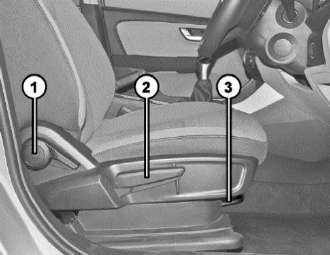
- Backrest recliner adjustment lever
- Seat height adjustment lever (if available)
- Seat forward / rearward adjustment lever
WARNING
Do not adjust the driver’s seat while driving. Adjusting the seat while driving could cause the driver to lose control of the vehicle.
Seat backrest angle adjustment
To change the seat back rest angle, lean forward slightly and pull up the lever (1). Adjust seat backrest until it reaches desired comfortable position. Make sure that lever returns to its original position and seat is securely latched.
NOTE
Adjust the seat backrest until your arms are slightly angled when holding the steering wheel.
WARNING
Do not travel in a moving vehicle with the seat backrest in an excessively reclined position as this can be dangerous.
Seat height adjustment
To raise the seat, pull and continue pumping the lever (2) in the upward direction until the seat is at the desired height. To lower the seat, pump the lever downward until the seat is at desired height.
Seat forward/rearward adjustment
Lift lever (3) and slide the seat forward or to the rear. Release lever and make sure that seat is securely latched.
NOTE
Adjust the driver seat position in such a way that the driver will be able to operate the control pedals comfortably.
Head restraint (if available)
Adjust the head restraint so that it is as close to the head as possible and the center of the head restraint supports the back of the head at eye level. This will reduce the risk of injury to the head and neck in the event of an accident or similar situation.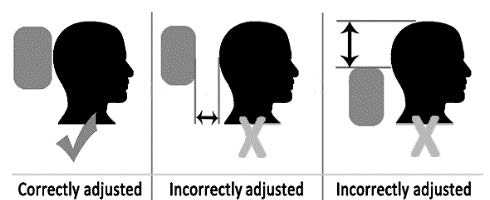
WARNING
Do not drive the vehicle without the seat head restraints. Head restraints are intended to help reduce injuries during an accident.
Front passenger seat sensor
An occupant detection sensor is installed in the front passenger seat to detect whether the seat is occupied or not and if occupied, it will activate the seat belt reminder warnings. The sensor does
not have any control on the deployment of airbags.
WARNING
Any modification in the seat material or addition of seat cover may damage or affect the performance of the sensor.
Rear seats
Rear seat folding (Complete Seat 100%)
To fold the seat:
Press the backrest release knobs provided on both sides at the same time.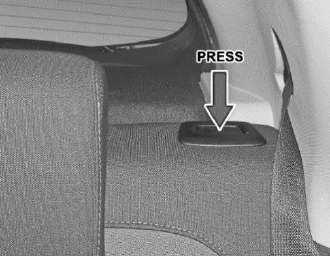
- Fold the backrest seat forward. Move the driver and front passenger seat forward if necessary.
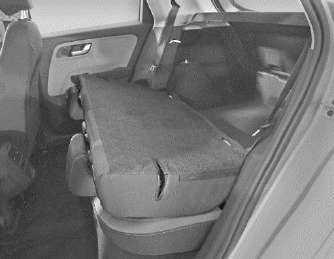
- WARNING
- If the rear bench seat and seat backrest are not latched properly, they could fold forwards during hard braking or in the event of a collision.
- The vehicle occupant would thereby be pushed into the seat belt by the rear bench seat or by the seat backrest. The seat belt can no longer offer the intended level of protection and could even cause injuries.
- Objects or loads in the trunk can-not be restrained by the seat backrest. There is an increased risk of injury.
- Before every trip, make sure that the seat backrests and the rear bench seat/rear seat are engaged and securely latched.
Rear View Mirrors
Inside Rear View Mirror (IRVM)
To adjust the mirror move the mirror up, down or sideways manually to obtain the best rear view. When you drive at night, set the selector tab to select anti-glare mode (if available) to reduce glare from the headlights of vehicles behind you.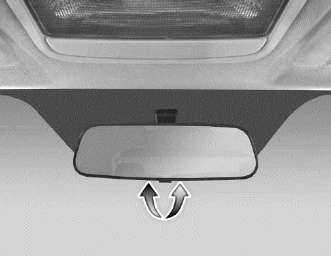
NOTE
Use antiglare position only when necessary, as it reduces rear view clarity.
Outer Rear View Mirrors (ORVM)
You can adjust the outer rear view mirrors manually (By hand) or remotely by knob. Adjust the outside rear view mirrors to desired position.
NOTE
Objects visible in mirror are actually closer than they appear. Always make sure of the actual distance from the road users traveling behind by glancing over your shoulder.
Motorized ORVM adjustment (if available)
The switch to adjust the motorized mirrors is located on the driver’s door. You can adjust the mirrors when the ignition switch is in the “ACC” or “ON” position.
To adjust the mirrors:
- Move the mirror selection switch to L (for left side) and R (for right side) to select the mirror you wish to adjust.
- Use the four positions of the knob to adjust the rear view mirrors to required position.
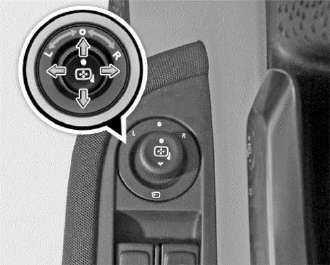
Manual ORVM adjustment (if available)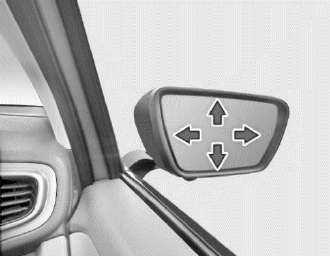
You can adjust the outer rear view mirrors manually.
WARNING
Do not adjust the mirror while driving. Adjusting the mirror while driving could cause the driver to lose control of the vehicle.
ORVM folding (as applicable)
Option 1: Manual folding
ORVMs can be folded or unfolded manually. This is applicable only for vehicles which are not equipped with motorized folding provision.
Option 2: Auto folding by smart key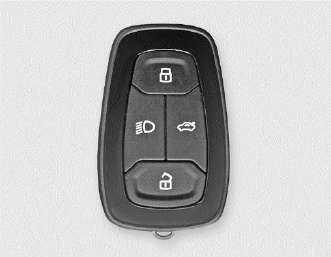
When you lock the vehicle, ORVMs will be folded automatically. When you unlock the vehicle, ORVMs will be unfolded automatically. In case to repeated usage, Mirror Folding/ Un-folding will stop functioning and will be re-activated after delay of 2 mins. During that period avoid repeated pressing of Switch.
Option 3:
Auto folding by knob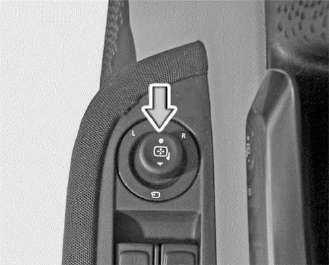
To fold / unfold the ORVMs, keep the Selector switch in center position (i.e. neither ‘L’ nor ‘R, position) and then toggle down. This will operate when the ignition switch is in the “ACC” or “ON” position.
Sun Visors (if available)
The sun visors can be pulled down to block the glare coming through the windshield. To block the glare from side windows, pull down the sun visor and release it from a retainer. Swing the sun visor to the side.
Vanity mirror (if available)
The vanity mirror is provided on the back of the front passenger side sun visor.
Electric Power Assisted Steering (EPAS)
Your vehicle is equipped with an electric power-assisted steering system. The EPAS system makes steering the vehicle easier with less effort. In the EPAS system, the steering effort becomes heavier as the vehicle speed increases and becomes lighter as the vehicle speed decreases for better control of the vehicle at different vehicle speeds. If the engine is ‘OFF’ or if the EPAS system becomes inoperative, the vehicle still can be steered with more steering effort. This EPAS system is available with the following assist features.
- Speed-sensitive assist control
- Active return control
NOTE
- A click noise may be heard from the EPAS relay after the ignition switch is turned ON or OFF position.
- The steering wheel may not un-lock normally in some cases when ignition key turned ‘ON’ or ‘ISS’ button is pressed. If this hap-pens, turn the steering wheel to the right or left slightly to unlock the steering wheel while turning the ignition key or pressing ISS button.
- Contact the nearest TATA authorized service center if in case of the above scenarios.
WARNING
Below are the symptoms of the system malfunction. Then, take your vehicle to the nearest TATA MOTORS service center and have the EPAS system checked as soon as possible.
- The EPAS warning light does not illuminate.
- Engine noise may be heard when the vehicle is driven at low speeds.
- If the EPAS system does not operate normally, the warning light will illuminate on the instrument cluster. The steering wheel rotation may become difficult to control or operate.
Steering wheel adjustment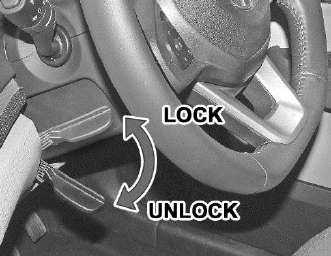
You can adjust the steering wheel position to suit your convenience. The release lever is located offset to the steering column.
- Adjust the seat to a comfortable position.
- Push “Tilt lever” completely down to unlock the steering column.
- Adjust the steering wheel to the de-sired position.
- Pull release lever up completely to lock the steering column.
- Make sure that steering wheel is securely locked by checking up and down direction.
NOTE
When adjusting the steering wheel, make sure that:
- You can operate control pedals without any obstacles.
- You can see all the displays in the instrument cluster clearly.
WARNING
Before you start the car, make sure the steering wheel position is locked. Do not unlock or adjust the steering wheel while the vehicle is in motion.
NOTE
The steering effort can suddenly increase, if the operation of the EPAS system is stopped to pre-vent serious accidents when it detects malfunction of the EPAS system during self-diagnosis.
When steering for a prolonged period, the steering effort will in-crease to prevent overheating and damage to the steering system.
Steering lock and ignition switch (if available)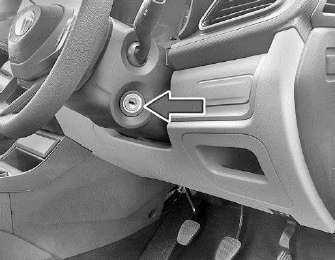
The ignition switch has the following four positions:
LOCK – This is the normal parking position. Key from lock can be removed in this position only.
“LOCK” position prevents normal use of the steering wheel after the key is removed. To release the steering lock, put the key in the slot and turn it clockwise to one click (ACC).
ACC – Accessories such as the infotainment system can be operated, but the engine remains ‘OFF’. Steering gets un-locked.
ON – This is the normal operating position. All electrical systems are ‘ON’.
START – Turn the key further clockwise to the START position, (spring loaded) to start the engine. As soon as the engine starts, release the ignition key, which re-turns to ON position. While cranking, all accessories will be momentarily ‘OFF’.
Illuminated Key Ring (if available)
When the vehicle is unlocked, the illuminated key ring glows. This helps to locate ignition switch in the dark.
Starting and stopping (without PEPS)
Starting the Engine
Make sure that parking brake is engaged and vehicle is in neutral gear. Press the clutch pedal fully and crank the engine. Do not press the accelerator pedal when starting the engine.
NOTE
The Starter protection system fitted in this vehicle does not allow you to crank the engine until you fully press the clutch pedal.
Release the key as soon as the engine starts. Repeat if engine does not start.
NOTE
The Starter protection system switches off the starter when it is continuously cranked for more than 10 secs. In such a case, get the key back to ‘OFF’ position & wait for 30 secs.
For vehicle equipped with turbocharger, after you start the engine, run the engine at idle speed for 30 seconds. Do not press accelerator pedal while starting the engine to avoid damage to the turbocharger.
Starting off
To start off, press the clutch pedal fully and shift into 1st gear. After releasing the parking brake, gradually release the clutch and slowly press the accelerator.
NOTE
When shifting or starting off, do not race the engine. Racing the engine can shorten engine life and affect smooth shifting.
Stopping the vehicle
For vehicle equipped with turbocharger, turn the key to ‘ACC’ position to switch off the engine. Before switching off the engine, run the engine at idle speed for 30 seconds and then switch off. This will allow the engine oil to lubricate the turbocharger, till its speed is fully reduced and also allow the unit to cool down.
WARNING
- Do not switch off the ignition while driving.
- For vehicle equipped with turbo-charger, do not switch the engine off when it is running at high speed. This will lead to premature turbocharger bearing wear.
- If you switch off the ignition while driving, safety-relevant functions are only available with limitations, or not at all. This could affect the power steering and the brake boosting effect. You will re-quire considerably more effort to steer and brake. There is a risk of an accident.
Starting and stopping (PEPS) (if available)
Engine Passive Start/Stop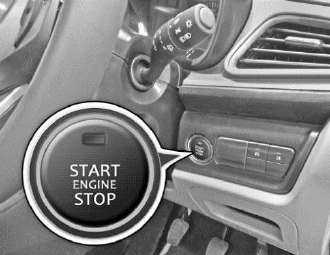
Start/Stop switch is provided on the dashboard towards the right side of steering wheel.
Start Stop button
The start/stop button or Push to Start Button is a main component of Passive (Engine) Start and Stop system. It is used to control ACC, IGN outputs as well as to start and stop the engine.
NOTE
- If smart key is inside the vehicle and on pressing start stop switch, if start stop switch green LED blinks more than 10 sec. duration then contact authorized TATA MOTORS dealer.
- If ESCL (Electronic Column Steering Lock) is not unlocked properly, then vehicle doesn’t go into ACC mode.
Backup start:
To start the engine when smart key battery voltage is low, the user needs to press start/stop button two times with an interval of 2.5 seconds after pressing the clutch with valid smart key near immobilizer antenna (in Centre Console).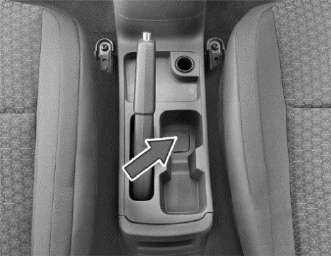
Emergency start
If the engine is switched from ON to OFF and start/stop button is pressed with clutch pressed within 5 seconds, engine gets cranked.
NOTE
If ESCL (Electronic Column Steering Lock) is not unlocked properly, then Engine will not get cranked.
Engine Passive Start – conditions
Single Press Start:
- Bring the smart key with you and sit in the driver seat.
- Press the clutch pedal and then press the start/stop switch.
- Green colours LED on start/stop but-ton will turn ON.
- Once engine is started successfully, the green colours LED on start/stop button stays ON.
- Two Step Start:
Step 1
- Have the smart key with you and sit on the driver’s seat.
- Press the start/stop button without pressing clutch pedal.
- Amber colours LED on start/stop switch turns ON.
- Engine will remain OFF and all electrical equipment and infotainment system can be used. Steering is un-locked.
Step 2
- Press the clutch pedal and then press start/stop button to start the engine.
- Green color LED on start/stop but-ton will turn ON.
- Once engine start successfully, green colours LED on start/stop switch will remain ON.
- Three Step Start:
- Step 1
- Have the smart key with you and sit on the driver’s seat.
- Press the start/stop button without pressing clutch pedal.
- Amber color LED on start/stop but-ton will turn ON.
- Limited information will be displayed on instrument cluster and steering will be unlocked. Engine remains OFF.
Step 2
- Press the start/stop button without pressing clutch pedal again.
- Green color LED on start/stop but-ton will turn ON.
- Engine will remain OFF but all electrical equipment and infotainment system can be used.
Step 3
- Press the clutch pedal and then press start/stop button to start the engine.
- Green color LED on start/stop button will turn ON.
- Once the engine is started successfully, the green cooler LED on start/stop button stays ON.
Engine Passive Stop – conditions
Single Press Stop:
- IGN is ON and engine is running.
- Press the start/stop button with or without clutch.
- ACC and IGN turns OFF.
- LED on start/stop switch turns OFF.
Single Press Stop:
- IGN is ON and engine is running.
- Press the start/stop button with or without clutch.
- ACC and IGN turns OFF.
- LED on start/stop switch turns OFF.
WARNING
When vehicle is in OFF mode (ACC, IGN and Crank OFF) and user tries to lock the vehicle from outside by pressing any door handle switch and if PEPS detects that the smart key is left inside the vehicle, an audio warning/ chime is sounded.
PEPS – Wearable Key (if available)
- You can wear it on wrist and drive the car (ease of carrying and usage).
- The key fob performs dual functions of passive entry/exit and passive start (similar functions of UID).
- Wearable device will work with PEPS vehicle only and it is an add-on de-vice along with the smart key.

PEPS Features
Passive Entry
Entry in Vehicle through Driver Door: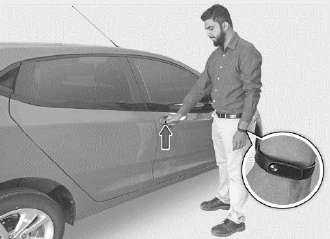
Press driver door handle button along with valid wearable key fob within the authentication range of 1.2 m.
Tailgate opening of vehicle:
Press tailgate handle button along with valid wearable key fob within the authentication range of 1.2 m.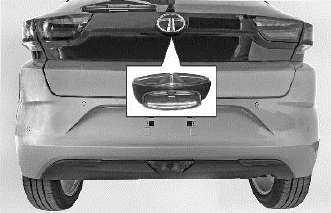
Tailgate switch
Passive exit
Exit from Vehicle through Driver Door
- Stop the car and turn off the ignition.
- Come out of the vehicle and close the door.
- Press the driver door handle button along with valid wearable key fob within the authentication range of 1.2 m.
- Vehicle get locked.
Engine Passive Start – conditions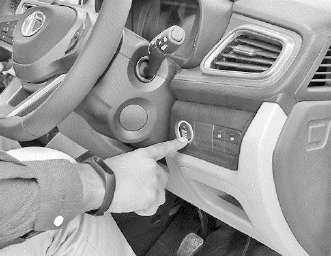
- Single Press Start:
- Bring the smart key with you and sit in the driver seat.
- Press the clutch pedal and then press the start/stop switch.
- Green color LED on start/stop button will turn ON.
- Once engine is started successfully, the green color LED on start/stop button stays ON.
Two Step Start:
- Have the smart key with you and sit on the driver’s seat.
- Press the start/stop button without pressing clutch pedal.
- Amber color LED on start/stop switch turns ON.
- Engine will remain OFF and all electrical equipment and infotainment system can be used. Steering is unlocked.
Step 2
- Press the clutch pedal and then press start/stop button to start the engine.
- Green color LED on start/stop but-ton will turn ON.
- Once engine start successfully, green color LED on start/stop switch will remain ON.
Three-Step Start:
Step 1
- Have the smart key with you and sit on the driver’s seat.
- Press the start/stop button without pressing clutch pedal.
- Amber colors LED on start/stop button will turn ON.
- Limited information will be displayed on the instrument cluster and steering will be unlocked. Engine remains OFF.
Step 2
- Press the start/stop button without pressing clutch pedal again.
- The green color LED on start/stop button will turn ON.
- The engine will remain OFF but all electrical equipment and infotainment system can be used.
Step 3
- Press the clutch pedal and then press start/stop button to start the engine.
- Green colours LED on start/stop but-ton will turn ON.
- Once the engine is started success-fully, the green colours LED on start/stop button stays ON.
Backup Start
If wearable key fob’s battery is low or drained, kindly refer the battery re-placement procedure of key fob in maintenance section. Customer should always carry the key fob along with wearable key.
In this condition, customer has to keep the key fob in center console antenna (refer below image).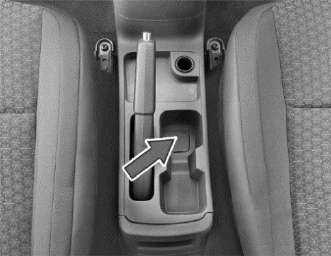
- To start the engine when the wearable key fob’s battery voltage is low or empty, user needs to press start/stop button two times with interval of 2.5 seconds along with the clutch. Engine will get cranked.
Engine Passive Stop – conditions
Single Press Stop:
- IGN is ON and engine is running.
- Press the start/stop button with or without clutch.
- ACC and IGN turns OFF.
- LED on start/stop switch turns OFF.
Single Long Press Stop:
- IGN is ON and engine is running.
- Vehicle is in running condition i.e. wheel rpm >10 RPM or wheel sensor faulty.
- Press the start/stop button for more than three seconds.
- IGN returns OFF, ACC remains ON.
- Amber color LED on start/stop switch turns ON.
WARNING
When a vehicle is in OFF mode (ACC, IGN, and Crank OFF) and the user tries to lock the vehicle from outside by pressing any door handle switch and if PEPS detects that the smart key is left inside the vehicle, an audio warning chime is sounded.
FAQ
A1: Insert the key fob into the ignition slot or press the brake pedal and press the “Engine Start/Stop” button if equipped, while holding the clutch pedal for manual transmission.
A2: Yes, the 2021 Tata Altroz BS VI is available with both manual and automatic transmission options.
A3: Press the clutch pedal, move the gear lever to the desired gear, release the clutch pedal gradually while pressing the accelerator, and release the clutch completely.
A4: Yes, some variants of the Altroz BS VI may come equipped with a hill-start assist feature that prevents the vehicle from rolling backward on inclines when starting.
A5: The Eco mode is a driving mode that optimizes the vehicle’s performance for better fuel efficiency. It adjusts engine response and other settings.
A6: Look for an “Eco” button or switch on the dashboard or center console, if equipped, and press it to activate Eco mode.
A7: The Sport mode is a driving mode that enhances the vehicle’s performance for a more dynamic driving experience. It adjusts engine response and other settings.
A8: If your Altroz is equipped with a Sport mode, look for a “Sport” button or switch on the dashboard or center console, and press it to activate Sport mode.
A9: The gear shift indicator is a visual prompt on the instrument cluster that suggests when to shift gears for optimal fuel efficiency.
A10: Some vehicles allow you to disable the gear shift indicator through the settings menu on the instrument cluster.
A11: The start-stop system automatically turns off the engine when the vehicle is stationary and in neutral gear, helping save fuel and reduce emissions. The engine restarts when you engage the clutch (for manual) or release the brake pedal (for automatic).
A12: In some vehicles, you may be able to disable the start-stop system using a button or switch on the dashboard or center console.
A13: The Altroz is designed for city driving with good maneuverability, compact size, and features that aid in traffic situations, making it well-suited for urban commutes.
A14: The recommended tire pressure can be found in the owner’s manual and is often indicated on a sticker inside the driver’s door frame or the fuel filler cap.
A15: To park the Altroz, find a suitable parking spot, engage the handbrake (if applicable), shift to “P” (for automatic) or engage first gear (for manual), and turn off the engine. Make sure the vehicle is properly aligned and secure before leaving.
Useful Link
View Full User Guide: Tata Altroz BS VI 2021 User Manual
Tata Altroz BS VI 2021 Night Driving User Manual


